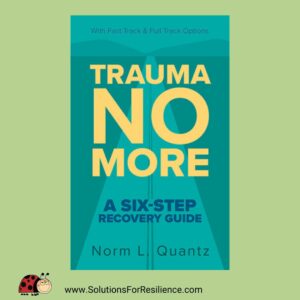Trauma No More: A Six-Step Recovery Guide – Book Summary
 As a therapist and author myself, I resonate with the intentions of Norm Quantz’s writing. He has been on the front line of couple therapy and wrote It’s All About Power and Control. His second work, Trauma No More: A Six-Step Recovery Guide is the result of numerous years of providing debriefs of distressing, traumatizing, events. He has observed, analyzed, pondered, supported, and developed understanding and protocols to better manage the humans involved. He’s committed to pragmatically helping.
As a therapist and author myself, I resonate with the intentions of Norm Quantz’s writing. He has been on the front line of couple therapy and wrote It’s All About Power and Control. His second work, Trauma No More: A Six-Step Recovery Guide is the result of numerous years of providing debriefs of distressing, traumatizing, events. He has observed, analyzed, pondered, supported, and developed understanding and protocols to better manage the humans involved. He’s committed to pragmatically helping.
His helpfulness touched me when recently I called him to ask for guidance. I was in a situation to support a family that had just experienced a murder. His questions and guidance provided comfort as I moved forward. You may experience something similar when you read Quantz’s work.
Note: Before embarking on any trauma exploration, even before reading this summary, let alone the book, you are cautioned to take slow, noticing, careful moves. Personal and emotional safety is crucial. Stop if you feel any overwhelm. Do something in the name of self-care.
Overview of Trauma No More
Using the metaphor of a highway you are guided through six steps. You can choose to thoroughly read the explanations, rationale, and action items for each step or do a fast-track read. Individuals, support-pairs, or groups can work through the steps.
In times of loss, for example, a group can benefit from moving through the steps together. I recall the staff of an elementary school coming together for mutual support after the unexpected death of their beloved principal. Trauma No More would have given them a road map.
Basic Concepts:
- Quantz defines trauma as a significant emotional or reactive response to an unexpected event or circumstance which causes distress and/or a reduced ability to cope.
- People can heal their trauma and move on from their ingrained and stuck responses which are presently tripping up the rest of their lives.
- Readers will not only want to thoroughly read through the guide as they journey through their trauma recovery, but often review the steps if they ever feel stuck.
STEP 1 – CHOOSE to ACT
Readers are given clear instructions to set up the foundation of your recovery journey. They start with a specific trauma-creating event, whether recent or in the past. Then they decide what supports, if any, they want in place. For example, support might be a friend, a trusted therapist, or a committed group. They also will consider where and when to embark on the steps.
Readers may have feelings of fear that surface or may feel hope that they are beginning this journey of exploration and relief.
STEP 2 – DESCRIBE your TRAUMA
Readers begin to write their brain’s recall of what happened, focusing on the most specific, predominant memories (sights, sounds, smells), body sensations, or emotions. The distance between what was expected and what happened is key to the resulting and personal distress. Where, when, who, and what? are explored and described.
This step is like mining your mind for significant evidence, look for what else is connected to this disruptive event?
STEP 3 – IDENTIFY your THEME
During this step readers are asked to allow a theme, which is connected to earlier life events, to emerge. This pain or life theme has the potential of taking readers deep into the core of their traumatic material. This is where emotional discomfort and repeated, haunting, or flooding memories (attached to taste, touch, sound, smell, sight, and thoughts) dwell.
Themes may be anchored in loss, fairness, abandonment, helplessness, unworthiness, distrust, or other deep and personal issues. Listing past events linked to the theme provides a significant timeline.
STEP 4 – EXPOSE the SOURCE and IMPACT
Readers are prompted to choose the earliest disruptive event (most often in childhood) related to their theme. Again, readers ponder, explore, and record the details of where, when, who, and what.
They become detectives searching for how coping strategies, personality traits, and core beliefs were developed to respond to and manage their painful life-theme.
STEP 5 – REINTERPRET your BELIEFS
Readers are then encouraged to identify a core belief that emerged from Step 4. This core belief is about them back then. Often the context is one of helplessness or lack of control. Then from a here and now perspective readers are invited to reassess the event and choose a more accurate and truthful belief about themselves. Turning beliefs that often begin with “I am (unlovable, helpless, undeserving, bad, stupid, or other)” are difficult to name, sometimes shaming. But the exercise of naming or reinterpreting them is crucial to healing. Quantz provides compassionate honesty to the process.
STEP 6 – AFFIRM your IDENTITY
As readers move forward, they complete the process by practicing a new self-belief with the statement, “I affirm that I really am: . . .” They build on a clearer sense of themselves as agents of their own lives, free from trauma.
Quotes by Norm Quantz
- Trauma impact seeps out through the words we speak and the small changes in our behavior.
- As much as you try, your mind does not stop remembering. Why? Because your brain is hurting and wants to share (download) the burden.
- When they surface, as they can in a traumatizing event, coping strategies are often rendered ineffective since they have not been adapted sufficiently to handle these unexpected overwhelming circumstances.
- When you discover your personally unique trauma theme, personal recovery will have the greatest opportunity for success.
- Raw emotions show up when one’s back is up against the proverbial wall and old historical reactions resurface. Rather than push these responses aside, let the trauma response, in whatever form it takes, be an opportunity to expose these tendencies.
- That was so long ago, you say! Yes. . . But you will gain insight into your trauma responses when you are able to make the connections between your developmental responses throughout life and the sources of those responses.
- Determine who you want to be instead of who you have become in response to your early trauma. You are not your trauma.
- You can get to a place where you sufficiently understand why certain events tend to traumatize you more than others, and since you know why, you will be able to navigate these experiences as a healthier person.
- Identifying beliefs and then reinterpreting them requires a candid, truthful acknowledgement of your deep inner thoughts and feelings. It may be painful to review them this late in life but beyond this pain, a renewed you awaits.
- Reinterpreting skewed beliefs to align with more accurate conclusions can help you discover the new you, the real person you have wanted to be all along.
- Traumatic experiences can be a catalyst for self-learning and improvement rather than a lifelong burden to bear or identity to share.
- Since trauma exposes an individual’s raw perspective on life it provides a great opportunity to know yourself better and make changes for good.
If you have for too long wondered, “Do I have trauma?” or have asked yourself if you could recover from trauma, please consider accessing the valuable recovery guide, Trauma No More.
Please check out these related posts:




